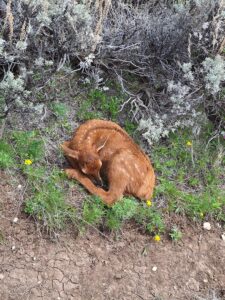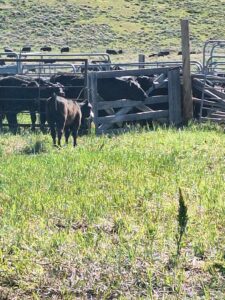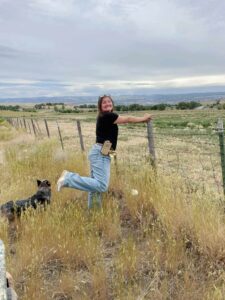Wildlife Friendly Fencing
#bfrdpwy #aginternship #RightRisk
This week I learned more about the wildlife friendly fencing and how the contracts work for that, also I practiced driving the skid steer. The NRCS and other agencies get money from the state to supply ranchers with the materials needed to replace existing fences with wildlife friendly fencing. This helps incentivize ranchers to install wildlife friendly fencing while also being helpful for the rancher. The ranchers get the opportunity to replace an old fence that may be worn out and not keeping cattle in properly, without having to pay for all new materials. The materials include t-posts, wood posts, in some cases pipe, barbed wire and smooth wire. On my host ranch, I have worked on installing wildlife friendly fencing on a couple different allotments on the Bighorn Mountains. My host prefers to use pipe to construct braces out of and weld the pipe pieces together to make them last much longer. We then lay out the t-posts followed by the wood posts at appropriate distances from one another before inserting them into the ground. Following installation of the posts, 3three strands of barbed wire and one strand of smooth wire is laid out and clipped to the posts. Lastly, gates are installed in the appropriate places.

The government agencies have regulations that must be followed when installing wildlife friendly fencing. For example, the smooth wire is required to be the bottom strand to allow for pronghorn and deer to crawl under the fence. All four strands of wire are also specific distances apart to allow for adequate room for animals to jump the fence if they prefer, such as elk. My host has constructed measuring sticks that allow for the people helping him, such as Dani and I, to clip the wire to the posts much more efficiently. The measuring sticks are as tall as the t-posts this operation uses, and my host welded tabs on the stick to the measurement that the state requires. When clipping the wire to the posts, all I need to do is place the measuring stick next to the t-post and hook the wire to the tabs, allowing for fast, accurate installation.

An issue I have learned about with wildlife friendly fencing is the bottom wire being smooth. It can cause problems for the rancher because when the calves are small, they can climb through it. I understand why the agencies require the bottom wire to be smooth; however, if it is costing ranchers in calves, I don’t see how ranchers will continue to get behind it. Another issue I have learned with wildlife friendly fencing is the amount of labor that is required to install it. My host operation has a great, efficient system that makes it easier to install, whereas other ranchers may not have the same equipment or manpower. This causes some ranchers to not be able to install the fencing because the government agencies only supply materials, not labor or equipment. I would question why the agencies couldn’t come up with a rental system for ranchers to use that would allow them to rent government equipment to install wildlife friendly fencing.

I appreciate getting to diversify my knowledge of ranching from cattle to fencing. Afterall, what good is having cows if you don’t have good fences? I plan to continue to learn about the contracts of wildlife friendly fencing installation and the pros and cons of it. I also look forward to seeing the cows in the pastures where we have installed the new fencing because it makes me feel good to know the cows are in a safe, secure environment for their time on the mountain.
Submitted by: Ronnie Owens
Edits by: GrowinG Internship Team

